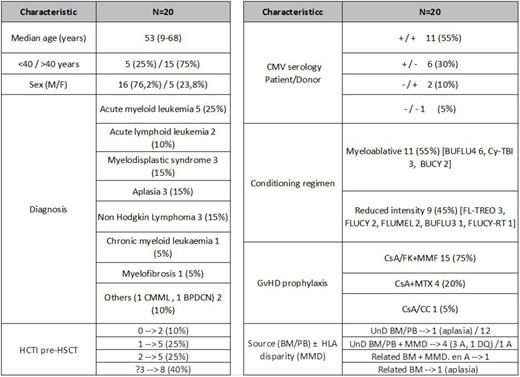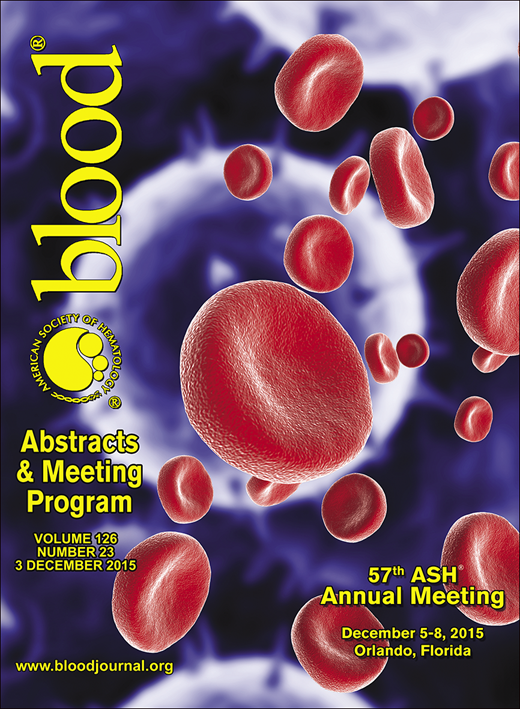Abstract
INTRODUCTION: Graft versus host disease (GvHD) is a major cause of morbidity and mortality after allogeneic hematopoietic stem cell transplantation (HSCT). ATG-Fresenius (ATG-F) has demonstrated its efficacy in reducing the risk of acute GvHD (aGvHD) and chronic GvHD (cGvHD) at a dose of 60 mg/kg (Finke J, Lancet Oncology, 2009; Sociè G, Blood, 2011), and at a dose of 30 mg/kg (Ayuk F, Biol Bone Marrow Transplant, 2008; Solano C, abstract EBMT, 2015).
AIMS: We analyzed as primary endpoint whether low dose ATG-F (21-32 mg/kg) might be effective in reducing the incidence of acute and chronic GvHD. The secondary endpoints were viral infections, non-relapse mortality (NRM), disease free survival (DSF) and overall survival (OS).
METHODS: Between September 2012 and December 2014, 22 patients who underwent HSCT received ATG-F in our hospital. Two patients were excluded because they received a second HSCT. We used ATG-F at a dose of 21 mg/kg (7 mg/Kg days -3,-2,-1) in the case of patients with hematologic malignancies who received a HSCT from an unrelated donor (UnD) with peripheral blood (PB) source and/or from a mismatched donor (MMD). ATG-F at a dose of 28-32 mg/kg (7-8 mg/kg days -4 to -1) was employed in aplasia. Median age was 53 years (9-68) and only 5 patients were <40 years. There were 6 patients with HLA disparity. Based on the new DRI (Disease Risk Index) classification, 11 cases ≥high risk. Only 8 patients underwent HSCT in 1st CR. The HCTI comorbidity index was ≥3 in 8 patients. A myeloablative conditioning was administered to 11 patients. Regarding CMV serology, 85% of patients were seropositive being and 35% high risk (patient +/donor -). See figure 1.
RESULTS: With a median follow up of 13 months (2.8-30.3), the cumulative incidence of grade II-IV and grade III-IV aGvHD was 40% (8/20 p) and 15% (3/20 p). Eighteen patients were valuable for cGvHD. Eleven patients developed cGvHD: 4 mild, 6 moderate (33.3%), and only 1 severe (5.5%).
Fifteen patients developed CMV infection (75%), which was recurrent in 3 of them. There were 2 cases of VEB plasma load and 1 patient developed EBV-PTLD (5%). Eight patients suffered from viral cystitis, in which the causal agents were JC/BK and adenovirus in 7 and 1 patients, respectively; none of these cases was severe (spontaneous resolution, lack of treatment).
The incidence of 1-year NRMwas 15%. Death causes were EBV-PTLD, refractory grade IV aGvHD and multiresistant Pseudomonas pneumonia. Relapse occurred in 5 patients (4/5 high risk disease), in the first 6 months in all of them, and it was the death cause in four of them. The 1-year OS and DFS were 60% and 55%.
CONCLUSION: In our cohort, that includes patients with advanced age and high risk of GvHD (HLA disparity and PB), low dose ATG-F seems to be effective in reducing the incidence of severe acute and chronic GvHD, with low NRM. The high incidence of CMV infection might be due to the elevated rate of seropositive patients. Finally, we think that our OS, DFS and relapse rates should be asses bearing in mind the elevated number of both high-risk disease and uncontrolled disease before HSCT that includes our cohort. However, longer follow-up and a higher number of patients are necessary to confirm all these results.
No relevant conflicts of interest to declare.
Author notes
Asterisk with author names denotes non-ASH members.


